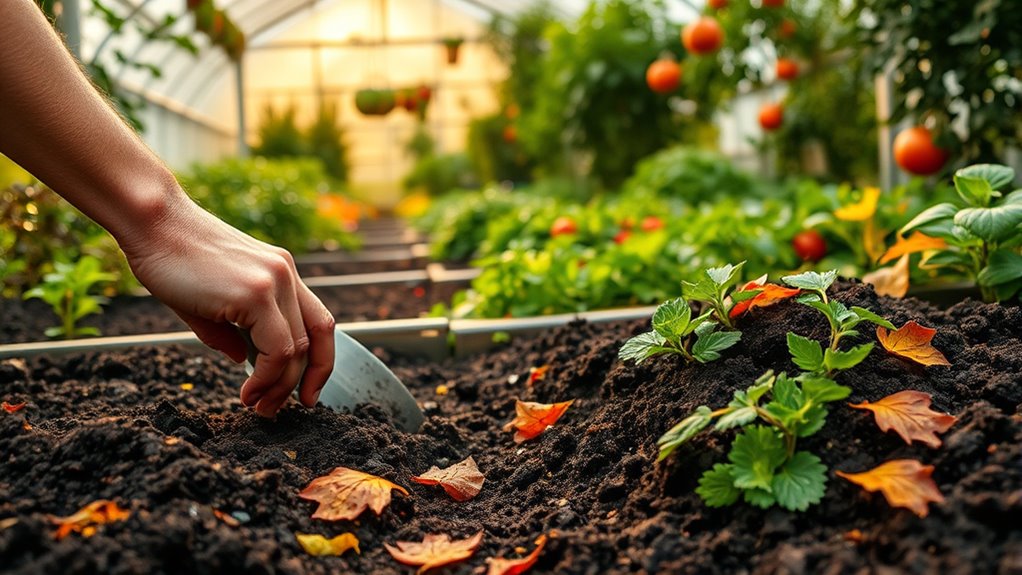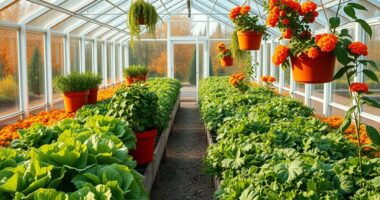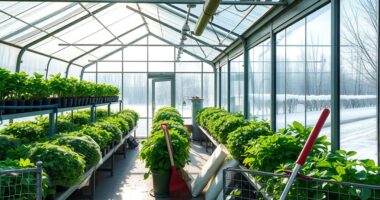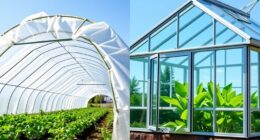For a successful fall harvest in your greenhouse, you need to maintain optimal temperatures around 70°F and select crops like leafy greens and root vegetables suited for cooler weather. Prepare your soil by testing pH and adding nutrients, and water less frequently while keeping humidity between 50%-80%. Keep an eye out for pests and disease, using natural remedies and rotation strategies to manage them. With these tips, you'll be ready for a bountiful autumn crop.
Key Takeaways
- Select cold-tolerant crops like leafy greens and root vegetables to thrive in cooler fall temperatures within the greenhouse.
- Maintain optimal temperatures around 70°F (21°C) and monitor for maximum heat to prevent plant stress.
- Regularly test and amend soil for pH and nutrients to support healthy growth during the fall season.
- Implement effective watering strategies, using moisture meters and drip irrigation to ensure consistent moisture without overwatering.
- Monitor for pests and diseases, using natural predators and crop rotation to maintain a healthy greenhouse environment.
Maintaining Optimal Temperatures for Fall Crops

When it comes to maintaining optimal temperatures for fall crops, understanding the cardinal temperatures is crucial. You need to know the minimum temperature for your specific crops, as it varies by species. Aim for the optimum temperature, around 70°F (21°C) for cool-season crops, to ensure rapid growth. Be cautious not to exceed the maximum temperature, where stress can hinder development. Temperature influences categorizing your crops as cold-tolerant or cold-sensitive helps you manage their needs effectively. Remember, optimal temperatures can change during different growth stages, like vegetative or flowering. To enhance growth, consider maintaining an appropriate day/night temperature differential, as it influences plant height and overall development. Proper management of these factors ensures a successful fall harvest.
Selecting the Right Crops for Fall Harvesting

As you gear up for fall harvesting, selecting the right crops is essential for a successful garden. Leafy greens like spinach, kale, and lettuce thrive in cooler temperatures, making them top choices. For a punch of flavor, consider adding leaf mustard or mizuna. Controlled environment protects these crops from frost, allowing you to enjoy fresh harvests even as temperatures drop. Additionally, backyard greenhouses can extend your growing season, giving you the opportunity to cultivate a variety of crops throughout the fall. It's also beneficial to monitor for aggressive behaviors among crops to ensure they coexist well in your greenhouse. A successful greenhouse also relies on understanding the specific needs of each plant variety.
Root vegetables like carrots and beets are perfect for fall planting, while radishes and turnips grow quickly and can be harvested in weeks. Don't forget about the cabbage family; varieties like broccoli and Napa cabbage flourish in cooler weather.
Incorporate herbs such as parsley and cilantro for fresh flavors. Finally, explore other options like peas and Swiss chard, which can enhance your fall harvest and offer nutritious additions to your table. Regular health checks on your plants can prevent disease transmission and promote a thriving garden.
Preparing Soil for Successful Growth

After selecting the right crops for your fall harvest, preparing the soil is key to ensuring those plants thrive.
Start with soil testing to check pH levels and nutrient content. If your soil's too acidic, add lime; if it's too alkaline, use elemental sulfur or peat moss. Implementing soil tests will help you assess pH balance and adjust accordingly for optimal growth.
Testing your soil's pH and nutrient levels is crucial; adjust acidity with lime or alkalinity with sulfur or peat moss.
Enhance nutrients with natural fertilizers and improve soil structure by adding compost, which boosts aeration and retains moisture.
To prevent compaction, regularly aerate your soil using garden forks, allowing roots to grow freely and water to penetrate.
Good drainage is essential, so make sure your soil isn't waterlogged.
Effective Watering and Humidity Management

Effective watering and humidity management are crucial for thriving fall gardens, especially as temperatures begin to drop.
In fall, you'll want to water less frequently, so monitor soil moisture with a moisture meter to avoid overwatering. Drip irrigation and self-watering containers are efficient methods that maintain consistent moisture levels. Water your plants early in the day to prevent dampness overnight, which can lead to fungal diseases. Additionally, consider amending soil with compost to enhance water retention in your greenhouse.
To manage humidity, aim for levels between 50% and 80%. Increase air circulation to reduce condensation on leaves, and group plants to create microenvironments that retain humidity.
Use hygrometers to track humidity and consider dehumidifiers or ventilation systems as needed. Adjust these levels based on seasonal changes and specific plant needs for optimal growth.
Implementing Pest and Disease Control Strategies

Implementing pest and disease control strategies is essential for maintaining a healthy fall garden, especially as cooler temperatures can invite unwanted pests.
Start by regularly inspecting your plants and using sticky traps to catch pests early. Accurate pest identification allows you to apply targeted control methods effectively.
Regular plant inspections and sticky traps are key for early pest detection and effective targeted control.
Consider introducing natural predators like ladybugs, and practice crop rotation to discourage pest buildup. Integrated pest management (IPM) emphasizes a holistic approach to pest control, combining various strategies for effective management.
Maintain cleanliness by removing plant debris and disinfecting tools to prevent disease spread. Seal gaps in your greenhouse to keep pests out, and quarantine new plants before introducing them.
Lastly, use pesticides sparingly and only when necessary, ensuring they're safe for your crops. Record keeping helps you track pest trends and adjust your strategies accordingly.
Maximizing Light and Shade in Your Greenhouse

Maintaining a healthy fall garden goes beyond pest control; it also involves optimizing the light and shade in your greenhouse.
Start by using shade cloth or roller screens to prevent sunburn and overheating. Automatic vents can help manage temperature and light levels effectively. Implementing shading and cooling systems can also enhance plant health during intense sunlight. Additionally, understanding the importance of energy-efficient technology can help you plan for unexpected events that may affect your greenhouse.
Depending on your region, you might need to adjust your lighting strategy—arid areas benefit from shading year-round, while high-latitude regions require supplemental lighting in winter.
Use a light meter to measure intensity and determine the Daily Light Integral (DLI) for your specific crops.
Remember, different plants have unique light needs; adjust your lighting systems accordingly.
Frequently Asked Questions
How Do I Extend the Growing Season in My Greenhouse?
To extend your growing season in the greenhouse, start by cleaning and sanitizing all surfaces to prevent diseases.
Test your soil to ensure it's nutrient-rich.
Consider adding insulation and heating to maintain warmth during colder months.
Use hoop houses or row covers to protect plants from frost.
Choose cool- or warm-season crops suited for your climate.
Finally, monitor temperature and irrigation, adjusting as needed to keep your plants thriving year-round.
What Are the Best Fall Companion Plants for Greenhouse Crops?
When choosing fall companion plants for your greenhouse crops, consider pairing leafy greens like kale and spinach with herbs such as dill and cilantro. They deter pests and enhance growth.
For root crops, plant carrots alongside radishes to improve soil quality. If you're growing legumes, beans and peas can enrich the soil while avoiding onions and garlic.
This combination maximizes space and promotes a healthier garden ecosystem. Happy planting!
How Can I Prevent Frost Damage to My Plants?
To prevent frost damage to your plants, start by covering them with fabric or plastic barriers to block cold winds.
Moving planters indoors can also keep them safe.
Mulching helps insulate the soil, while watering moist soil retains warmth better.
Monitor weather forecasts for frost warnings, and prioritize tender plants for protection.
If needed, use row covers or bubble wrap to provide extra insulation, ensuring your plants stay healthy through cold nights.
What Tools Are Essential for Fall Greenhouse Gardening?
Did you know that nearly 75% of gardeners report using hand tools regularly?
For effective fall greenhouse gardening, you'll need essential tools like hand pruners for trimming, a trowel for planting, and scissors for quick cuts.
Don't forget gloves to protect your hands!
Watering cans and sprinklers are vital for irrigation, while rakes help maintain tidy soil.
Finally, keep disinfectants on hand to sanitize tools and prevent disease.
How Do I Properly Store My Harvested Fall Crops?
To properly store your harvested fall crops, start by ensuring the right temperature and humidity for each type.
For root vegetables, keep them at 32°F with high humidity.
Cure squash in a warm, dry place before storing in a cool area.
Make sure to handle everything gently to avoid bruising.
Use perforated bags for ventilation, and regularly clean your storage space to prevent disease.
Tailor conditions to each crop for the best results.
Conclusion
As the days grow shorter and the air turns crisp, your greenhouse becomes a sanctuary for bountiful fall harvests. Picture plump pumpkins and vibrant greens thriving under your care. But beware—unseen pests lurk in the shadows, and temperatures can drop unexpectedly. Stay vigilant, adjust your strategies, and nurture your plants with love and precision. The reward? A cornucopia of fresh produce waiting to fill your table. Will you rise to the challenge and reap the fruits of your labor?









